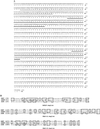Insect juvenile hormone resistance gene homology with the bHLH-PAS family of transcriptional regulators
- PMID: 9501163
- PMCID: PMC19642
- DOI: 10.1073/pnas.95.6.2761
Insect juvenile hormone resistance gene homology with the bHLH-PAS family of transcriptional regulators
Abstract
Juvenile hormone analog (JHA) insecticides are relatively nontoxic to vertebrates and offer effective control of certain insect pests. Recent reports of resistance in whiteflies and mosquitoes demonstrate the need to identify and understand genes for resistance to this class of insect growth regulators. Mutants of the Methoprene-tolerant (Met) gene in Drosophila melanogaster show resistance to both JHAs and JH, and previous biochemical studies have demonstrated a mechanism of resistance involving an intracellular JH binding-protein that has reduced ligand affinity in Met flies. We cloned the Met+ gene by transposable P-element tagging and found reduced transcript level in several mutant alleles, showing that underproduction of the normal gene product can lead to insecticide resistance. Transformation of Met flies with a Met+ cDNA resulted in susceptibility to methoprene, indicating that the cDNA encodes a functional Met+ protein. MET shows homology to the basic helix-loop-helix (bHLH)-PAS family of transcriptional regulators, implicating MET in the action of JH at the gene level in insects. This family also includes the vertebrate dioxin receptor, a transcriptional regulator known to bind a variety of environmental toxicants. Because JHAs include a diverse array of chemicals with JH activity, a mechanism whereby they can exert effects in insects through a common pathway is suggested.
Figures




Comment in
-
Juvenile hormone resistance: ! no PASaran !Proc Natl Acad Sci U S A. 1998 Mar 17;95(6):2725-6. doi: 10.1073/pnas.95.6.2725. Proc Natl Acad Sci U S A. 1998. PMID: 9501155 Free PMC article. No abstract available.
References
-
- Riddiford L M. In: Comprehensive Insect Physiology, Biochemistry, and Pharmacology. Kerkut G, Gilbert L I, editors. Vol. 8. New York: Pergamon; 1985. pp. 37–84.
-
- Nijhout H F, Wheeler D E. Q Rev Biol. 1982;57:109–133.
-
- Staal G B. Annu Rev Entomol. 1975;20:417–460. - PubMed
-
- Riddiford L M. Adv Insect Physiol. 1994;24:213–274.
-
- Zhang J, Saleh D S, Wyatt G R. Mol Cell Endocrinol. 1996;122:15–20. - PubMed
Publication types
MeSH terms
Substances
Associated data
- Actions
LinkOut - more resources
Full Text Sources
Other Literature Sources
Molecular Biology Databases
Miscellaneous

